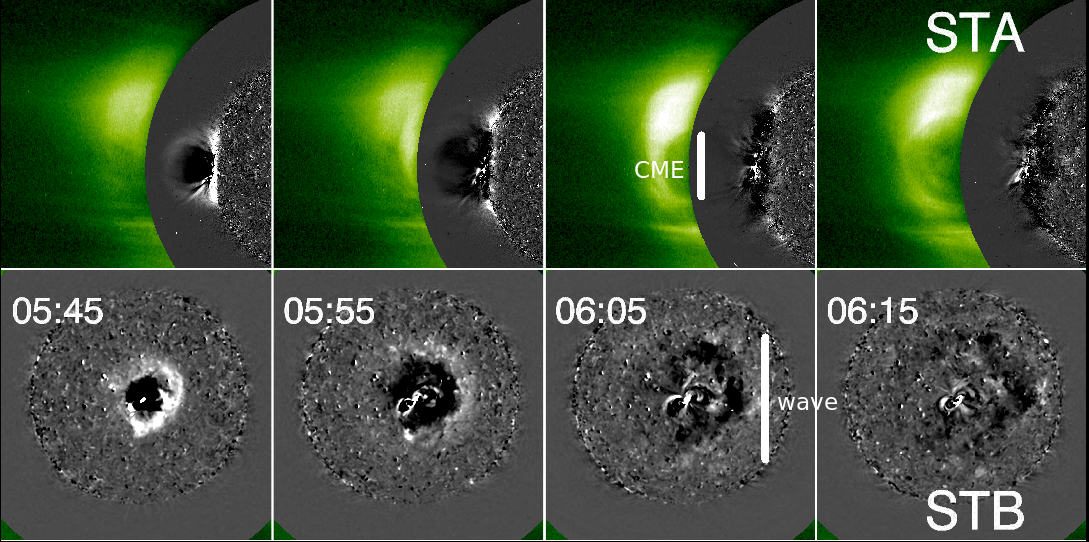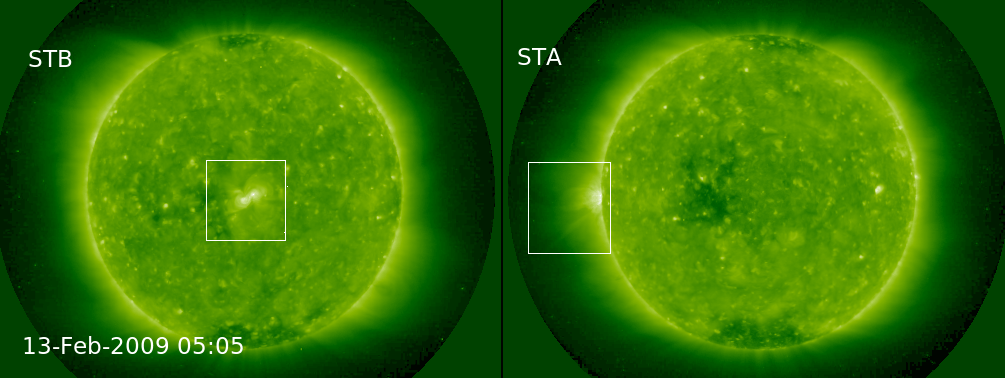|
Important notice about STEREO Behind
Do Solar Tsunami's Exist?
The twin STEREO spacecraft confirmed their reality in February 2009 when sunspot 11012 unexpectedly erupted. The blast hurled a billion-ton cloud of gas (a coronal mass ejection, or CME) into space and sent a tsunami racing along the sun's surface. STEREO recorded the wave from two positions separated by 90 degrees, giving researchers an unprecedented view of the event.
"It was definitely a wave," says Spiros Patsourakos of George Mason University, lead author of a paper reporting the finding in Astrophysical Journal Letters. "Not a wave of water, but a giant wave of hot plasma and magnetism."
The complete article appeared on the NASA portal (Nov. 19, 2009) here:
http://www.nasa.gov/mission_pages/stereo/news/solar_tsunami.html
Below STEREO is providing additional movies and images not included with the article that support this finding.
-
A "mug shot" of a solar coronal wave: A short video sequence showing observations from STEREO Behind ("SC B") and Ahead ("SC B") of the coronal wave event. STEREO Behind (left)sees the wave "full face," or head on, while STEREO A (right) gets a profile; the two spacecraft were just over 90� apart at the time. The grey parts of the image are formed by subtracting successive pairs of images from the SECCHI Extreme Ultraviolet Imager (EUVI) taken in an emission line of eleven-times ionized iron at 195 Å, and characteristic of plasma at 1.5 million Kelvin. The green-white color table shows part of the field of view of the SECCHI COR1 visible-light coronagraph, which records light from the surface of the Sun scattered from free electrons in the highly ionized solar corona.

STEREO Ahead ("STA") and Behind ("STB") views of the coronal wave event. The Behind spacecraft views (bottom) show the wave expanding over much of the solar hemisphere visible from that spacecraft, while the Ahead spacecraft (top) shows the expanding coronal mass ejection (CME) bubble leaving the EUVI field of view (grey difference images) and entering the COR1 field of view (green images).

Images of the Sun from the STEREO Behind ("STB") and Ahead ("STA") spacecraft's SECCHI Extreme Ultraviolet Imager (EUVI) instrument, obtained on February 13, 2009, in a spectral line formed at 1.5 million Kelvin. The spacecraft orbit the Sun just inside (Ahead) and outside (Behind) the earth's orbit; in February, they were 90� apart, so Behind was able to observe the boxed active region nearly at disk center, while Ahead saw it on the limb, or edge of the Sun.
Last Revised: Friday, 20-Nov-2009 15:47:34 EST
Responsible NASA Official: ![[email address: therese.a.kucera<at>nasa<dot>gov]](/img/kucera_email.jpg)
Privacy Policy and Important Notices
Accessibility
Webmaster: Apexa Patel
|